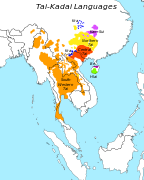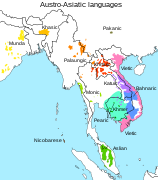Austric languages
| Austric | |
|---|---|
| (controversial) | |
| Geographic distribution |
Southeast Asia, South Asia, Taiwan, Madagascar, East Asia |
| Linguistic classification | proposed language family |
| Subdivisions |
|
| Glottolog | None |
 Map of the Austric languages. | |
Austric[1] is a large hypothetical grouping of languages primarily spoken in Southeast Asia and Pacific. It includes the Austronesian language family of Taiwan, the Malay Archipelago, Pacific Islands, and Madagascar, as well as the Austroasiatic language family of mainland Southeast Asia, India, Nepal and Bangladesh. The hypothesis of a genetic relationship between these two language families is not widely accepted among linguists.
Additional sometimes the Kra–Dai languages, the Japonic languages and the Hmong–Mien languages are included by some linguists.[2][3] This proposal would be called Greater Austric languages.[4][5]
Related proposals include Sino-Austronesian (Laurent Sagart) and Austro-Tai and Austro-Tai-Japanese (both from Paul K. Benedict).[6]
Contents
1 History
2 Classification schemes
2.1 Starosta (2005)
3 Distributions
4 See also
5 References
6 Further reading
7 External links
History
The Austric superfamily was first proposed by the German missionary Wilhelm Schmidt in 1906. He showed phonological, morphological, and lexical evidence to support the existence of an Austric phylum consisting of Austroasiatic and Austronesian (in particular, Malayo-Polynesian), but the lexical evidence was considered to be tenuous by the larger linguistic community. Consequently, the Austric hypothesis has never gained wide acceptance. In 1942, Paul K. Benedict extended the Austric hypothesis to include the Kra–Dai languages, Japanese language and the Hmong–Mien (Miao–Yao) languages.
Despite the tenuous lexical evidence, the relationship of Austronesian with either Austroasiatic or Kra–Dai has many proponents to this day, mostly on morphological grounds. Some believe that recently discovered morphological similarities between Nicobarese and Austronesian constitute solid proof of a genetic relationship. Other researchers are still searching for the missing lexical link between Austronesian and Austroasiatic or Kra–Dai. Reid (2005) summarizes the present state of the Austric hypothesis.
Murray Gell-Mann, Ilia Peiros, and Georgiy Starostin maintain that the Austric hypothesis is less well supported than several other linguistic macrofamilies, including Sino-Caucasian, Eurasiatic, and Afroasiatic since "no detailed proto-Austric glossaries or equally detailed tables of correspondences between the various daughter branches of Austric have been produced."[7] An expanded Greater-Austric has been suggested to include the Ainu languages and possibly the Nihali language though this is currently not a mainstream view.[8] In contrast to these older proposals subsumed under the label Austric, an exclusive relationship of Austronesian with the Ongan languages (but not other Andamanese languages) has been suggested (Blevins 2007) but has no support by mainstream linguists.
Echoing part of Benedict's version of the Austric proposal, Kosaka (2002) argued specifically for a Miao–Dai family.[9]
A 2015 analysis using the Automated Similarity Judgment Program resulted in support for the Austric and the Nostratic languages, where Japonic languages were most closely grouped with the Ainu and the Austroasiatic languages. Thought the linguist doing this research said himself that this program only compared today languages and not the proto-languages. Thus it can be not used to classify the origin of the languages.[10]
Classification schemes
The following classification scheme, proposed by Paul K. Benedict, is the most commonly accepted one. Hmong–Mien languages are occasionally included, but are often rejected from the Austric superfamily.
.mw-parser-output table.clade{border-spacing:0;margin:0;font-size:100%;line-height:100%;border-collapse:separate;width:auto}.mw-parser-output table.clade table.clade{width:100%}.mw-parser-output table.clade td{border:0;padding:0;vertical-align:middle;text-align:center}.mw-parser-output table.clade td.clade-label{width:0.8em;border:0;padding:0 0.2em;vertical-align:bottom;text-align:center}.mw-parser-output table.clade td.clade-slabel{border:0;padding:0 0.2em;vertical-align:top;text-align:center}.mw-parser-output table.clade td.clade-bar{vertical-align:middle;text-align:left;padding:0 0.5em}.mw-parser-output table.clade td.clade-leaf{border:0;padding:0;text-align:left;vertical-align:middle}.mw-parser-output table.clade td.clade-leafR{border:0;padding:0;text-align:right}
Austric |
|
||||||||||||||||||||||||
| |
Sergei Starostin, however, splits Austric into two main branches. The Austric branch would be considered to be most closely related to Dené–Caucasian, forming a Dene-Daic super-family:[11]
Austric |
|
||||||||||||||||||
| |
Starosta (2005)
Stanley Starosta (2005)[12] includes Sino-Tibetan, Austronesian, Kra–Dai, Austroasiatic, and Hmong–Mien as part of an East Asian superphylum, which he also alternatively refers to as Sino-Tibetan–Austronesian ("STAN") (see also Sino-Austronesian languages). Unlike Benedict's Austric family, Starosta's East Asian family includes Sino-Tibetan. Starosta (2005) considers Proto-East Asian to have been a disyllabic (CVCVC) language spoken from 6,500 to 6,000 BCE by Peiligang culture and Cishan culture millet farmers on the North China Plain (specifically the Han River, Wei River, and central Yellow River areas).
East Asian
Austronesian
- Formosan
- Extra-Formosan
- Kra–Dai
- Malayo-Polynesian
- Sino-Tibetan-Yangzian
- Sino-Tibetan
- Yangzian
- Austroasiatic
- Hmong–Mien
Starosta (2005) proposes the following Proto-East Asian morphological affixes, which are found in Proto-Tibeto-Burman and Proto-Austronesian, as well as in some morphologically conservative Austroasiatic branches such as Nicobaric.[13]
- *m(V)- 'agent of V-ing'
- *-Vn 'patient of V-ing'
- *sV- 'instrument of V-ing'
- *n(V)- 'perfective'
The linguist Juha Janhunen found during his analysis of Asian languages strong similarities between proto-Japanese and language like Sino-Tibetan, Tai-Kadai and Hmong-Mien languages. He says, similar to Vovin, that proto-Japanese originated somewhere in southeast China or the Shandong peninsula.[14]
Distributions
.mw-parser-output .mod-gallery{display:table}.mw-parser-output .mod-gallery-default{background:transparent;margin-top:0.5em}.mw-parser-output .mod-gallery-center{margin-left:auto;margin-right:auto}.mw-parser-output .mod-gallery-left{float:left}.mw-parser-output .mod-gallery-right{float:right}.mw-parser-output .mod-gallery-none{float:none}.mw-parser-output .mod-gallery-collapsible{width:100%}.mw-parser-output .mod-gallery .title{display:table-row}.mw-parser-output .mod-gallery .title>div{display:table-cell;text-align:center;font-weight:bold}.mw-parser-output .mod-gallery .main{display:table-row}.mw-parser-output .mod-gallery .main>div{display:table-cell}.mw-parser-output .mod-gallery .caption{display:table-row;vertical-align:top}.mw-parser-output .mod-gallery .caption>div{display:table-cell;display:block;font-size:94%;padding:0}.mw-parser-output .mod-gallery .footer{display:table-row}.mw-parser-output .mod-gallery .footer>div{display:table-cell;text-align:right;font-size:80%;line-height:1em}.mw-parser-output .mod-gallery .gallerybox .thumb img{background:none}.mw-parser-output .mod-gallery .bordered-images img{border:solid #eee 1px}.mw-parser-output .mod-gallery .whitebg img{background:#fff!important}.mw-parser-output .mod-gallery .gallerybox div{background:#fff!important}

Distribution of Kra–Dai languages

Distribution of Austroasiatic languages

Distribution of Hmong–Mien languages

Distribution of Austronesian languages
See also
- Classification schemes for Southeast Asian languages
- Haplogroup O-M175#Languages families and genes
- Mainland Southeast Asia linguistic area
References
^ http://ehl.santafe.edu/EhlforWeb.pdf
^ Schmidt, Wilhelm (1930). ""Die Beziehungen der austrischen Sprachen zum Japanischen", 'The connections of the Austric languages to Japanese'". Wiener Beitrag zur Kulturgeschichte und Linguistik. 1: 239–51.
^ Benedict, Paul K. (1990). Japanese/Austro-Tai. Karoma. ISBN 9780897200783..mw-parser-output cite.citation{font-style:inherit}.mw-parser-output .citation q{quotes:"""""""'""'"}.mw-parser-output .citation .cs1-lock-free a{background:url("//upload.wikimedia.org/wikipedia/commons/thumb/6/65/Lock-green.svg/9px-Lock-green.svg.png")no-repeat;background-position:right .1em center}.mw-parser-output .citation .cs1-lock-limited a,.mw-parser-output .citation .cs1-lock-registration a{background:url("//upload.wikimedia.org/wikipedia/commons/thumb/d/d6/Lock-gray-alt-2.svg/9px-Lock-gray-alt-2.svg.png")no-repeat;background-position:right .1em center}.mw-parser-output .citation .cs1-lock-subscription a{background:url("//upload.wikimedia.org/wikipedia/commons/thumb/a/aa/Lock-red-alt-2.svg/9px-Lock-red-alt-2.svg.png")no-repeat;background-position:right .1em center}.mw-parser-output .cs1-subscription,.mw-parser-output .cs1-registration{color:#555}.mw-parser-output .cs1-subscription span,.mw-parser-output .cs1-registration span{border-bottom:1px dotted;cursor:help}.mw-parser-output .cs1-ws-icon a{background:url("//upload.wikimedia.org/wikipedia/commons/thumb/4/4c/Wikisource-logo.svg/12px-Wikisource-logo.svg.png")no-repeat;background-position:right .1em center}.mw-parser-output code.cs1-code{color:inherit;background:inherit;border:inherit;padding:inherit}.mw-parser-output .cs1-hidden-error{display:none;font-size:100%}.mw-parser-output .cs1-visible-error{font-size:100%}.mw-parser-output .cs1-maint{display:none;color:#33aa33;margin-left:0.3em}.mw-parser-output .cs1-subscription,.mw-parser-output .cs1-registration,.mw-parser-output .cs1-format{font-size:95%}.mw-parser-output .cs1-kern-left,.mw-parser-output .cs1-kern-wl-left{padding-left:0.2em}.mw-parser-output .cs1-kern-right,.mw-parser-output .cs1-kern-wl-right{padding-right:0.2em}
^ !MOTHER TONGUE - JOURNAL OF THE ASSOCIATION FOR THE STUDY OF LANGUAGE IN PREHISTORY by Wilhelm Schmidt 1999
^ Driem, George van (2001). Handbuch Der Orientalistik. BRILL. ISBN 9004120629.
^ Solnit, David B. (1992). "Japanese/Austro-Tai By Paul K. Benedict (review)". Language. 68 (1): 188–196. doi:10.1353/lan.1992.0061. ISSN 1535-0665.
^ Gell-Mann, Murray; Peiros, Ilia; Starostin, George (2009). "Distant Language Relationship: The Current Perspective" (PDF). Journal of Language Relationship. 1: 13–30.
^ Bengtson, John (2010). "The "Greater Austric" Hypothesis" (PDF).
^ Kosaka, Ryuichi (2002). "On the affiliation of Miao-Yao and Kadai: Can we posit the Miao-Dai family" (PDF). Mon-Khmer Studies. 32: 71–100.
^ Gerhard Jäger, "Support for linguistic macrofamilies from weighted sequence alignment." PNAS vol. 112 no. 41, 12752–12757, doi: 10.1073/pnas.1500331112. Published online before print September 24, 2015.
^ van Driem, George (2005). "Sino-Austronesian vs. Sino-Caucasian, Sino-Bodic vs. Sino-Tibetan, and Tibeto-Burman as default theory" (PDF). In Yadava, Yogendra P. Contemporary Issues in Nepalese Linguistics. Linguistic Society of Nepal. pp. 285–338. ISBN 978-99946-57-69-8. (see page 309)
^ Starosta, Stanley. 2005. "Proto-East Asian and the origin and dispersal of the languages of East and Southeast Asia and the Pacific." Laurent Sagart, Roger Blench & Alicia Sanchez-Mazas, eds. The Peopling of East Asia: Putting Together Archaeology, Linguistics and Genetics. London: Routledge Curzon, pp. 182–197.
^ Reid, Lawrence A. 1994. Morphological evidence for Austric. Oceanic Linguistics 33(2):323-344.
^ ユハ・ヤンフネン 「A Framework for the Study of Japanese Language Origins」『日本語系統論の現在』(pdf) 国際日本文化センター、京都、2003年、477-490頁。
Further reading
.mw-parser-output .refbegin{font-size:90%;margin-bottom:0.5em}.mw-parser-output .refbegin-hanging-indents>ul{list-style-type:none;margin-left:0}.mw-parser-output .refbegin-hanging-indents>ul>li,.mw-parser-output .refbegin-hanging-indents>dl>dd{margin-left:0;padding-left:3.2em;text-indent:-3.2em;list-style:none}.mw-parser-output .refbegin-100{font-size:100%}
- Benedict, Paul K. 1976. Austro-Thai and Austroasiatic. In: Philip N. Jenner, Laurence C. Thompson, and Stanley Starosta, eds., Austroasiatic Studies, Part I, pp. 1–36. Honolulu: University of Hawai‘i Press.
- Blazhek, Vaclav. 2000. Comments on Hayes "The Austric Denti-alveolar Sibilants". Mother Tongue V:15-17.
Blevins, Juliette (2007). "A Long Lost Sister of Proto-Austronesian? Proto-Ongan, Mother of Jarawa and Onge of the Andaman Islands". Oceanic Linguistics 46 (1): 154–198.
Blust, Robert. 1996. Beyond the Austronesian homeland: The Austric hypothesis and its implications for archaeology. In: Prehistoric Settlement of the Pacific, ed. by Ward H.Goodenough,
ISBN 978-0-87169-865-0 DIANE Publishing Co, Collingdale PA, 1996, pp. 117–137. (Transactions of the American Philosophical Society 86.5. (Philadelphia: American Philosophical Society).- Blust, Robert. 2000. Comments on Hayes, "The Austric Denti-alveolar Sibilants". Mother Tongue V:19-21.
Diffloth, Gerard F. 1989. What Happened to Austric? Mon–Khmer Studies XVI-XVII:1-9.- Diffloth, Gerard. 1994. The lexical evidence for Austric so far. Oceanic Linguistics 33(2):309-321.
- Fleming, Hal. 2000. LaVaughn Hayes and Robert Blust Discuss Austric. Mother Tongue V:29-32.
- Hayes, La Vaughn H. 1992. On the Track of Austric, Part I: Introduction. Mon–Khmer Studies XXI:143-77.
- Hayes, La Vaughn H. 1997. On the Track of Austric, Part II: Consonant Mutation in Early Austroasiatic. Mon–Khmer Studies XXVII:13-41.
- Hayes, La Vaughn H. 1999. On the Track of Austric, Part III: Basic Vocabulary Correspondence. Mon–Khmer Studies XXIX:1-34.
- Hayes, La Vaughn H. 2000. The Austric Denti-alveolar Sibilants. Mother Tongue V:1-12.
- Hayes, La Vaughn H. 2000. Response to Blazhek's Comments. Mother Tongue V:33-4.
- Hayes, La Vaughn H. 2000. Response to Blust's Comments. Mother Tongue V:35-7.
- Hayes, La Vaughn H. 2000. Response to Fleming's Comments. Mother Tongue V:39-40.
- Hayes, La Vaughn H. 2001. On the Origin of Affricates in Austric. Mother Tongue VI:95-117.
- Hayes, La Vaughn H. 2001. Response to Sidwell. Mother Tongue VI:123-7.
- Larish, Michael D. 2006. Possible Proto-Asian Archaic Residue and the Statigraphy of Diffusional Cumulation in Austro-Asian Languages. Paper presented at the Tenth International Conference on Austronesian Linguistics, 17–20 January 2006, Puerto Princesa City, Palawan, Philippines.
- Reid, Lawrence A. 1994. Morphological evidence for Austric. Oceanic Linguistics 33(2):323-344.
- Reid, Lawrence A. 1996. The current state of linguistic research on the relatedness of the language families of East and Southeast Asia. In: Ian C. Glover and Peter Bellwood, editorial co-ordinators, Indo-Pacific Prehistory: The Chiang Mai Papers, Volume 2, pp . 87-91. Bulletin of the Indo-Pacific Prehistory Association 15. Canberra: Australian National University.
- Reid, Lawrence A. 1999. New linguistic evidence for the Austric hypothesis. In Selected Papers from the Eighth International Conference on Austronesian Linguistics, ed. by Elizabeth Zeitoun and Paul Jen-kuei Li, pp. 5–30. Taipei: Academia Sinica.
- Reid, Lawrence A. 2005. The current status of Austric: A review and evaluation of the lexical and morphosyntactic evidence. In The peopling of East Asia: putting together archaeology, linguistics and genetics, ed. by Laurent Sagart, Roger Blench and Alicia Sanchez-Mazas. London: Routledge Curzon.
- Schmidt, Wilhelm. 1906. Die Mon–Khmer-Völker, ein Bindeglied zwischen Völkern Zentralasiens und Austronesiens [The Mon–Khmer Peoples, a Link between the Peoples of Central Asia and Austronesia]. Archiv für Anthropologie, Braunschweig, new series, 5:59-109.
- Schmidt, Wilhelm. 1930. Die Beziehungen der austrischen Sprachen zum Japanischen [The Connections of the Austric Languages to Japanese]. Wien Beitrag zur Kulturgeschichte und Linguistik 1:239-51.
- Shorto, H. L. 1976. In Defense of Austric. Computational Analyses of Asian and African Languages 6:95-104.
- Sidwell, Paul. 2001. Comments on La Vaughn H. Hayes' "On the Origin of Affricates in Austric". Mother Tongue VI:119-121.
- Van Driem, George. 2000. Four Austric Theories. Mother Tongue V:23-27.
External links
- Phonologies of selected Austronesian and Austroasiatic languages
- Glossary of purported lexical links among Austronesian and Austroasiatic languages
- Papers on the Austric hypothesis
- Word lists
- Austronesian Basic Vocabulary Database: Austronesian, Tai–Kadai, Hmong–Mien, Austro-Asiatic word lists
Comparative Tai–Kadai and Hmong–Mien Swadesh vocabulary lists (from Wiktionary's Swadesh-list appendix)





Comments
Post a Comment